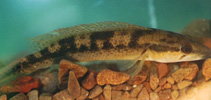| Family: |
Cichlidae (Cichlids), subfamily: Cichlinae |
| Max. size: |
24.7 cm SL (male/unsexed) |
| Environment: |
benthopelagic; freshwater |
| Distribution: |
South America: Brazil. |
| Diagnosis: |
Dorsal spines (total): 20-24; Dorsal soft rays (total): 11-13; Anal soft rays: 8-11. Distinguished from all other costal southeastern Brazilian species of the Crenicichla lacustris group by having a row of 5-8 dark blotches along middle of side and narrow vertical bars absent. This is most similar to Crenicichla punctata in color pattern, males always feature a pattern of irregularly distributed dark spots over the sides, but this pattern is lost in breeding females. Differs from Crenicichla punctata by the absence of minute dark spots on the head. Also distinguished from Crenicichla haroldoi, Crenicichla jaguarensis and Crenicichla jupiaensis by E1 row scale counts 60-75. Differs from Crenicichla iguassuensis by having a row of 5-8 dark blotches along side and snout pointed with lower jaw distinctly prognathous and from Crenicichla niederleinii by absence of narrow vertical bars (Ref. 57632). |
| Biology: |
Feeds on bivalves, gastropods, fish and coleopteran larvae (Ref. 57632). |
| IUCN Red List Status: |
Least Concern (LC); Date assessed: 07 November 2018 Ref. (130435)
|
| Threat to humans: |
harmless |
Source and more info: www.fishbase.org. For personal, classroom, and other internal use only. Not for publication.

